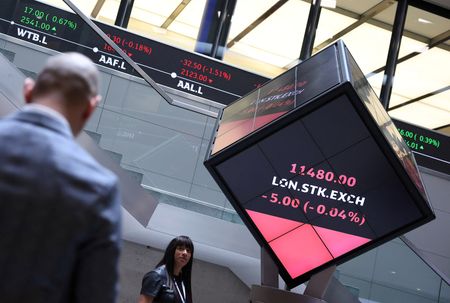By Lucia Mutikani
WASHINGTON (Reuters) -The U.S. trade deficit widened to a record high in March as businesses boosted imports of goods ahead of President Donald Trump’s sweeping tariffs, which dragged gross domestic product into negative territory in the first quarter for the first time in three years.
The report from the Commerce Department on Tuesday showed the nation imported a record amount of goods from 10 countries, including Mexico and Vietnam. Imports from China were, however, the lowest in five years and could drop further as Trump has hiked duties on Chinese goods to a staggering 145%.
There are reports of a massive decline in cargo from China.
While reciprocal tariffs with most U.S. trade partners were suspended for 90 days, duties on Chinese goods came into effect in early April, triggering a trade war with Beijing. Economists expect the front-running of imports probably persisted in April.
“Businesses are clearly scrambling as they try to find a way through this time of unprecedented change, but the worst is undoubtedly yet to come because the import tariff collections did not start to roll in earnest until after the White House ‘Liberation Day’ announcement on April 2,” said Christopher Rupkey, chief economist at FWDBONDS. “There are still no trade deals announced in Trump 2.0.”
The trade gap jumped 14.0%, or $17.3 billion, to a record $140.5 billion, the Commerce Department’s Bureau of Economic Analysis said. Economists polled by Reuters had forecast the trade deficit would rise to $137.0 billion.
Imports vaulted 4.4% to an all-time high $419.0 billion. Goods imports soared 5.4% to a record $346.8 billion. They were boosted by a $22.5 billion jump in consumer goods to an all-time high, mostly made up of pharmaceutical products from Ireland. Trump has promised to impose duties on pharmaceutical goods.
Capital goods imports increased $3.7 billion to a record high, reflecting a solid rise in computer accessories. Imports of automotive vehicles, parts and engines increased $2.6 billion, driven by passenger cars.
But imports of industrial supplies declined $10.7 billion amid a $10.3 billion decrease in finished metal shapes, likely silver, and a $1.8 billion drop in non-monetary gold, which had accounted for the wider trade gap in the prior two months.
Economists said this data suggested capital flight out of the U.S. dollar as the White House’s ever-changing tariffs policy spooked investors. Crude oil imports fell $1.2 billion.
“The post-November elections period from December 2024 to March 2025 saw a cumulative hoarding of offshore gold and silver bullion on a year-over-year basis of $92.5 billion,” said Brian Bethune, an economics professor at Boston College. “This ‘parking’ of scarce U.S. savings into non-productive, non-income earning assets has negative consequences for the U.S. dollar.”
The dollar has weakened about 5.11% so far this year against the currencies of the main U.S. trade partners. The currency was trading lower against a basket of currencies on Tuesday.
Stocks on Wall Street also fell while U.S. Treasury yields were mixed.
Federal Reserve officials began a two-day policy meeting on Tuesday. While the U.S. central bank is expected to keep interest rates unchanged on Wednesday, Fed Chair Jerome Powell’s press conference will be watched for clues on when policy easing might resume.
EXPORTS RISE MARGINALLY
Exports climbed 0.2% to $278.5 billion, also a record high. Exports of goods increased 0.7% to $183.2 billion, the highest level since July 2022, lifted by industrial supplies and materials, which advanced $2.2 billion amid rises in natural gas and non-monetary gold.
Automotive vehicles, parts and engines exports increased $1.2 billion. But exports of capital goods decreased $1.5 billion, weighed down by a $1.8 billion decline in shipments of civilian aircraft. The goods trade deficit ballooned 11.2% to a record $163.5 billion in March.
The government reported last week that the trade deficit cut a record 4.83 percentage points from GDP last quarter, resulting in the economy contracting at a 0.3% annualized rate, the first decline since the first quarter of 2022.
Trump sees the tariffs as a tool to raise revenue to offset his promised tax cuts and to revive a long-declining U.S. industrial base. Economists expect the flood of imports to ebb by May, which could help GDP rebound in the second quarter.
They, however, caution that the lift from subsiding imports could be limited by a drop in exports as other nations boycott U.S. goods and travel. There has been a decrease in the number of visitors to the U.S., especially from Canada, in protest over the punitive tariffs as well as an immigration crackdown and Trump’s musings about annexing Canada and Greenland.
Indeed, exports of services fell $0.9 billion to $95.2 billion in March, pulled down by a $1.3 billion drop in travel.
The rush to beat tariffs saw imports from Mexico, the United Kingdom, Ireland, the Netherlands, Belgium, France, Germany, Italy, India and Vietnam hitting all-time highs. But imports from China were the lowest since March 2020, when the world was grappling with the first wave of the COVID-19 pandemic.
The seasonally adjusted goods trade deficit with China narrowed to $24.8 billion from $26.6 billion in February. The trade deficit with Canada also declined to $4.9 billion from $7.4 billion in February. The trade gap with Mexico was little changed, while the surplus with the UK narrowed.
“Imports from the EU were substantial in March, particularly from Ireland, and may decline in April,” said Veronica Clark, an economist at Citigroup. “But if anything, imports from some Asian countries may rise further as larger 40%-50% tariffs were delayed until July.”
(Reporting by Lucia Mutikani; Editing by Chizu Nomiyama, Andrea Ricci and Paul Simao)










